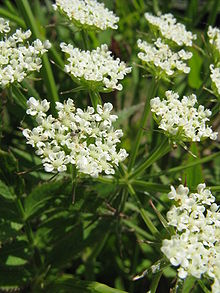Merk (genus)
| Mark | ||||||||||||
|---|---|---|---|---|---|---|---|---|---|---|---|---|

Broad-leaved Merk ( Sium latifolium ) |
||||||||||||
| Systematics | ||||||||||||
|
||||||||||||
| Scientific name | ||||||||||||
| Sium | ||||||||||||
| L. |
The plant genus Merk ( Sium ) belongs to the umbelliferae family (Apiaceae). The approximately 10 to 15 species have their distribution areas in Africa , Eurasia and North America .
description

Sium species grow as perennial herbaceous plants . They are marsh or water plants . In some species, bundles with thickened roots are formed. The above-ground parts of the plant are bare. Roots can be formed at the lower nodes of the branched stems . The stalked leaves are unpinnate. The sessile pinna leaflets often have a serrated edge.
The flowers stand together in terminal or lateral inflorescences ; they are double umbels with simple or divided bracts and lanceolate envelopes, which are usually bent back. The relatively small flowers are hermaphrodite, radial symmetry and five-fold with a double flower envelope . The five, often unequal, sepals are conspicuous or tiny, sometimes falling off early. The five petals are white. The outer flowers of a double umbel often have elongated petals.
The smooth fruits have a carpophor that is split in two to the base .
Systematics and distribution

The genus Sium was established in 1753 by Carl von Linné in Species Plantarum , 1, p. 251. As a lectotype species Sium latifolium L. was introduced in 1929 by Albert Spear Hitchcock in Prop. Brit. Bot. , P. 140.
There are 10 to 15 types of Sium (selection):
- Sium frigidum Handel-Mazzetti : This endemic thrives at altitudes of around 3500 meters only in Zhongdian in northwestern Yunnan .
- Broad-leaved Merk , Great Merk, Merle or water celery ( Sium latifolium L. ): It is widespread in Europe, Kazakhstan , Central Asia , Siberia and Xinjiang .
- Sium latijugum C.B.Clarke : It grows in the Himalayas .
- Sium medium Fischer & CAMeyer: It iswidespreadin Kazakhstan, Kyrgyzstan , Tajikistan , Uzbekistan and Xinjiang.
- Sium sisaroideum DC. : It iswidespreadfrom Southwest Asia to Central Asia in Afghanistan, Kazakhstan, Kyrgyzstan, Russia, Tajikistan, Turkmenistan , Uzbekistan and Xinjiang.
- Sugar root ( Sium sisarum L. ): It is widespread from Hungary, Eastern and Southeastern Europe through Western Asia and the Caucasus to Central Asia.
- Sium suave Walter (Syn .: Sium cicutifolium Schrenk , Sium formosanum Hayata , Sium nipponicum Maxim. ): The wide distribution area in the northern hemisphere ranges from East Asia (China, Taiwan, Japan , Korea ) to Siberia as well as Russia's Far East and North America from Alaska via Canada and into the USA (many states up to Florida as the southernmost).
No longer belonging to the genus Sium :
- Narrow-leaved Merk ( Sium erectum Huds. , Sium angustifolium L. , Sium thunbergii DC. ) ⇒ Ordinary Berle ( Berula erecta (Huds.) Coville )
- Sium douglasii DC. ⇒ Cicuta douglasii (DC.) JMCoult. & Rose
swell
- Pu Fading (溥 发 鼎 Pu Fa-ting) & Mark F. Watson: Sium , p. 115 - online with the same text as the printed work , In: Wu Zheng-yi & Peter H. Raven (eds.): Flora of China , Volume 14 - Apiaceae through Ericaceae , Science Press and Missouri Botanical Garden Press, Beijing and St. Louis, 2005. ISBN 1-930723-41-5 (sections description and classification)
- E. Nasir: Umbelliferae , Volume 20: Sium at Tropicos.org. In: Flora of Pakistan . Missouri Botanical Garden, St. Louis
- ML Gonçalves: Umbelliferae in the Flora Zambesiaca , Volume 4, 1978: Sium - Online.
Individual evidence
- ^ Sium at Tropicos.org. Missouri Botanical Garden, St. Louis, accessed on May 23, 2014.
- ↑ a b c d e f Pu Fading (溥 发 鼎 Pu Fa-ting) & Mark F. Watson: Sium , p. 115 - online with the same text as the printed work , In: Wu Zheng-yi & Peter H. Raven (ed. ): Flora of China , Volume 14 - Apiaceae through Ericaceae , Science Press and Missouri Botanical Garden Press, Beijing and St. Louis, 2005. ISBN 1-930723-41-5
- ↑ a b c d e Sium in the Germplasm Resources Information Network (GRIN), USDA , ARS , National Genetic Resources Program. National Germplasm Resources Laboratory, Beltsville, Maryland. Retrieved May 23, 2014.